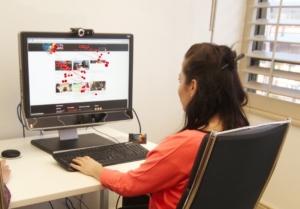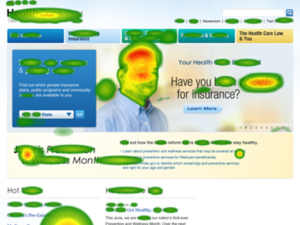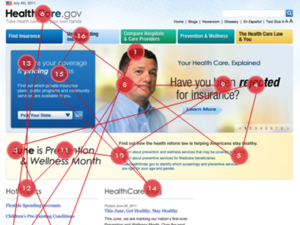
Eye tracking is a tool utilized by UX researchers in usability testing to record users’ eye behavior when they are conducting a user test on an interface. It is usually equipped with a tracker that is installed on the device, where its camera is directly facing the user’s pupils. The software generates data on heat maps and saccade pathways to help researchers identify the insights the data reveal.
When I was watching the user test videos from Usertesting.com for my previous assignment, I had generated great curiosity on those moments when users paused the move of their mouse and thought about the next step. I was always wondering what they were looking at when they were not moving the mouse. I have had experience in face-to-face user test where I saw the user looking at the correct button to click but did not actually click. It helped me understand that the purpose of the button may not be clearly communicated. However, researchers are not able to capture all user’s eye behavior. I am particularly interested in learning about how eye tracking could help UX researchers better conduct user research and if it is worth the money for it to be implemented in all the research.
Eye tracking is the observation and recording of a user’s eye behavior, such as pupil dilation and movement. In a user research, it helps researchers to identify where uses are looking, how long they are looking, how their focus moves from item to item on the web page, what parts of the interface they miss, how they are navigating the length of the page, and how size and placement of items on the web page affects attention. These are all important factors where insights could be extracted from later synthesis to facilitate the understanding of users. Once the user finishes the test, a software will generates data on a heat map and a saccade pathways map.

A heat map represents where the user concentrated their gaze and how long they gazed at a given point. Generally, the color scale from blue to red indicates the duration of a user’s focus. The red area shows where the user focuses for a longer period of time on the page. The blue areas shows a place with a short period of attention.

Saccade pathways trace the eye’s movement between areas of focus. Saccade pathways trace the eye’s movement between areas of focus. A red circle is the area of focus, while the red line indicates the flight.
Having discussed its functions, eye tracking seems to be a powerful tool to facilitate user research. However, due to its high cost, it is also argued that if it’s worth it to implement eye tracking in most of the user research studies. Looking at the limitations of eye tracking, although it can capture the eye movement to help researchers uncover many valuable insights from users, there are some tasks eye tracking cannot complete. First of all, eye tracking cannot tell why users spend more time fixating on a certain element. It cannot tell for certainty that users see something conscientiously or they do not see something. Thus, it is suggested that eye tracking would only be recommended to use when there is enough budget and when all less expensive testing methods have been completed, such as interviews, surveys, and observations.
I agree that as researchers, we should always start with the most fundamental qualitative testing methods. When it becomes a necessity, I believe eye tracking would be greatly helpful when conducted by experienced researchers who know how to operate the procedure and interpret the data.
Resources:
- http://www.usability.gov/how-to-and-tools/methods/eye-tracking.html
- http://usabilitygeek.com/what-is-eye-tracking-when-to-use-it/